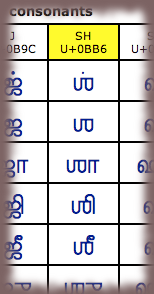In my personal experience I have given several non-mic concerts. The most recent being one in Europe. The best part was that they provided mics with monitor speakers just for feedback, whilst the audience listened to the true sound as they would like to call it.
Monday, August 11, 2008
Thoughtfulness
Sunday, August 03, 2008
Tamil 'sha': Unicode to the rescue
 In the previous post, I had argued for including the Grantha letter 'sha' in Tamil. I was very happy to find out that Unicode 4.1.0 has already done so. Its code-point is 0x0BB6.
In the previous post, I had argued for including the Grantha letter 'sha' in Tamil. I was very happy to find out that Unicode 4.1.0 has already done so. Its code-point is 0x0BB6.It looks like this version of Unicode was released in March 2005. This means that Tamil fonts created before, such as the default one in Windows XP, will not have this character. If you are interested, you can download the "Lohit" tamil font, which supports the new code-point. It should work on Windows and Linux. (Not sure about Mac.)
As I feared, there were some anti-Sanskrit folks who fought against this character. From a Unicode mailing-list thread on this subject:
Sanskrit is always seen a wanton intrusion [sic] to destroy all Indic languages and cause confusion. Tamil has been defending itself for hundreds of years.... Unicode is not the entity that should decide the demise of the ancient and sophisticated Tamil, like the demise of all other Indic languages.... 0BB6 must be deprecated. 0BB6 was encoded illegally by Unicode.
I am pleasantly surprised that, inspite of this, 0BB6 made it through.
Right now in translipi, I use ச to transliterate 'sha' into Tamil. This is fine for the cases where it is accompanied by a vowel. However, when it appears as a pure consonant or together with other consonants, ச is conventionally pronounced 'cha' in Tamil. This is not very satisfactory; the grantha 'sha' letter fits the bill perfectly here. However, since not many fonts support it yet, translipi will go along with ச for 'sha' for some more time.
Sunday, July 27, 2008
One more character for Tamil
- There are no characters for aspirates.
- A single character is used for both voiced and unvoiced sounds. E.g., the character க represents the guttural sounds 'ka' and 'ga' (and also 'ha'). The character ச is used for the sounds 'ca', 'ja' and 'za' (and sometimes 'Sa').
But not anymore. A large fraction of the current generation of Tamil-speakers bear names that are Hindi-like. Venkatesh (veGkaTez) where the traditional version would have been Venkatesan. Shankar as opposed to the traditional Sankaran. Satish or Akash, which were never prevalent in the previous generations. And there is no Tamil character which can unambiguously represent the za sound.
As of now, we make do using ஷ (Sa) which is not the same sound at all. I feel time is ripe for Tamil to make space for one more character from Grantha (
However, given the anti-Sanskrit leanings of Tamil scholars, I am not sure if this will happen.
Saturday, July 26, 2008
Sri Santhanam
On one occasion, while introducing Maharajapuram Santhanam to the audience at a felicitation function at the Music Academy, [Semmangudi] said: “He is my guru’s son. When he was a little boy, I would toss him up in the air and play with him, but now [sizing him up with his eyes], I can’t quite manage that.” [Link]A related observation from the Music Season of 1990:
Still the person who attracts most crowds is Maharajapuram Santhanam and the present theory in Madras is that this attraction is purely gravitational. [Ramesh Mahadevan]
Sunday, April 27, 2008
It's been long
In Japan, employees occasionally work themselves to death. It's called Karoshi. I don't want that to happen to anybody in my department.
The trick is to take a break as soon as you see a bright light and hear dead relatives beckon.
— Pointy Haired Boss, in a Dilbert cartoon
Things were (and still are) tough at the workplace for quite a few months. Many times, it is the Dilbert cartoon I have quoted above that has helped me retain sanity. This is the main cause of my long silence.
Till I can post next, here is a mp3 version of a classic shellac recording of M. Balamuralikrishna with my idol M. S. Gopalakrishnan on the violin, for your listening pleasure. Any further words are redundant.
- - -
I am also pleased to inform you that sahityam.net is coming along well, with both the content and the traffic increasingly slowly but steadily. It has received some good words and has also attracted a few contributors. The bulk of the content is due to the sterling efforts of Sri V. Govindan. (An example: Nada sudha)